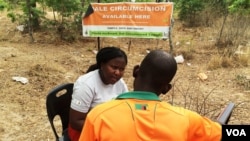Zimbabwe is one of the countries hardest hit by the AIDS epidemic. For the past couple of years, the government has been urging men to get circumcised, a procedure that lowers the risk of getting infected with the HIV virus. Now, officials are pushing the newly-introduced ring method that makes the procedure easier.
These men have just been circumcised using the ring method. They watch a football match as others undergo the procedure in a nearby tent.
The technique involves inserting a plastic ring inside the foreskin. A rubber ring is placed on the outside. The ring blocks bloodflow to the foreskin and in a few days, both the ring and the foreskin can be removed.
In 2009, the government set the target to have 1.3 million men circumcised by 2017 to slow the spread of HIV.
Zimbabwe was falling short of this target with the surgical method, according to Malvern Nyamana – the chief medical officer in Shurugwi rural district. He says the ring method, introduced this year, has made a big difference.
"We are seeing that a lot of certain section of population were not quite keen on coming for circumcision, especially young adults and older men ranging from 18 around 29 are now willing to come because of this method which saves time – they want to come in and go. With no injections and less hassles, they continue their daily business as usual," said Nyamana.
He says the ring method is less painful and less expensive.
An 18-year-old man heads out to play football after his procedure.
"With the ring method, you can do all your usual chores. Some people, like me, were afraid of surgical circumcision, but there is nothing to be afraid of with the ring method. Nothing has changed since I got the ring on me," he said.
Zimbabwe rolled out the ring method with funding from the U.S. President's Emergency Plan for Aids Relief (PEPFAR) and U.S.-based Population Services International (PSI).
The World Health Organization says there is compelling evidence that male circumcision reduces the risk HIV infection in men by approximately 60 percent.
However, the U.N. body specifies that male circumcision only reduces, not eliminates risk. It says people should still use protection, practice abstinence and avoid multiple sex partners.
That is the same message Zimbabwean health officials preach to men here before they line up to be circumcised.





